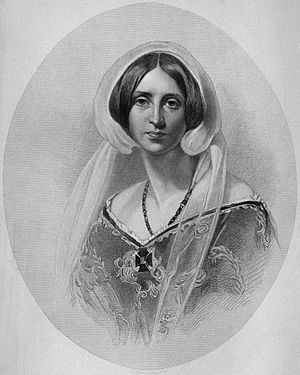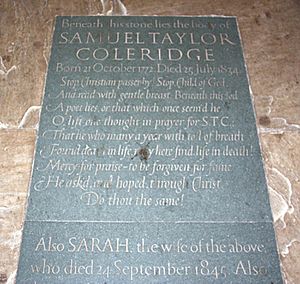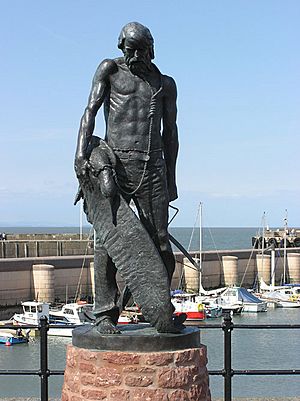Samuel Taylor Coleridge facts for kids
Quick facts for kids
Samuel Taylor Coleridge
|
|
|---|---|
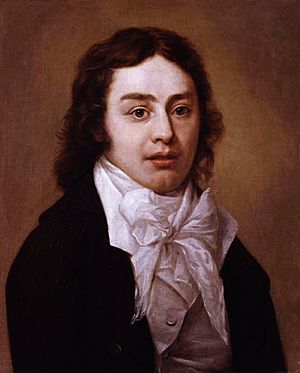
Coleridge in 1795
|
|
| Born | 21 October 1772 Ottery St Mary, Devon, Great Britain |
| Died | 25 July 1834 (aged 61) Highgate, Middlesex, United Kingdom |
| Occupation |
|
| Alma mater | Jesus College, Cambridge |
| Literary movement | Romanticism |
| Notable works | The Rime of the Ancient Mariner, Kubla Khan, Christabel, Conversation poems, Biographia Literaria |
| Spouse | Sara Fricker |
| Children | Hartley Coleridge Berkeley Coleridge Sara Coleridge Derwent Coleridge |
| Relatives | James Coleridge (brother) |
|
|
|
| Signature | |
Samuel Taylor Coleridge (/ˈkoʊlərɪdʒ/ koh-LƏ-rij; 21 October 1772 – 25 July 1834) was an English poet, literary critic, philosopher, and theologian who, with his friend William Wordsworth, was a founder of the Romantic Movement in England and a member of the Lake Poets. He also shared volumes and collaborated with Charles Lamb, Robert Southey, and Charles Lloyd. He wrote the poems The Rime of the Ancient Mariner and Kubla Khan, as well as the major prose work Biographia Literaria. His critical work, especially on William Shakespeare, was highly influential, and he helped introduce German idealist philosophy to English-speaking cultures. Coleridge coined many familiar words and phrases, including "suspension of disbelief". He had a major influence on Ralph Waldo Emerson and American transcendentalism.
Throughout his adult life, Coleridge had crippling bouts of anxiety and depression; it has been speculated that he had bipolar disorder, which had not been defined during his lifetime. He was physically unhealthy, which may have stemmed from a bout of rheumatic fever and other childhood illnesses.
Contents
Early life and education
Coleridge was born on 21 October 1772 in the town of Ottery St Mary in Devon, England. Samuel's father was the Reverend John Coleridge (1718–1781), the well-respected vicar of St Mary's Church, Ottery St Mary and was headmaster of the King's School, a free grammar school established by King Henry VIII (1509–1547) in the town. He had previously been master of Hugh Squier's School in South Molton, Devon, and lecturer of nearby Molland.
John Coleridge had three children by his first wife. Samuel was the youngest of ten by the Reverend Mr. Coleridge's second wife, Anne Bowden (1726–1809), probably the daughter of John Bowden, Mayor of South Molton, Devon, in 1726. Coleridge suggests that he "took no pleasure in boyish sports" but instead read "incessantly" and played by himself.
After John Coleridge died in 1781, 8-year-old Samuel was sent to Christ's Hospital, a charity school which was founded in the 16th century in Greyfriars, London, where he remained throughout his childhood, studying and writing poetry. At that school Coleridge became friends with Charles Lamb, a schoolmate, and studied the works of Virgil and William Lisle Bowles.
In one of a series of autobiographical letters written to Thomas Poole, Coleridge wrote: "At six years old I remember to have read Belisarius, Robinson Crusoe, and Philip Quarll – and then I found the Arabian Nights' Entertainments – one tale of which (the tale of a man who was compelled to seek for a pure virgin) made so deep an impression on me (I had read it in the evening while my mother was mending stockings) that I was haunted by spectres whenever I was in the dark – and I distinctly remember the anxious and fearful eagerness with which I used to watch the window in which the books lay – and whenever the sun lay upon them, I would seize it, carry it by the wall, and bask, and read."
He later wrote of his loneliness at school in the poem Frost at Midnight: "With unclosed lids, already had I dreamt/Of my sweet birthplace."
From 1791 until 1794, Coleridge attended Jesus College, Cambridge. In 1792, he won the Browne Gold Medal for an ode that he wrote attacking the slave trade.
In December 1793, he left the college and enlisted in the 15th (The King's) Light Dragoons using the false name "Silas Tomkyn Comberbache", perhaps because of debt or because the girl that he loved, Mary Evans, had rejected him. His brothers arranged for his discharge a few months later under the reason of "insanity" and he was readmitted to Jesus College, though he would never receive a degree from the university.
Pantisocracy and marriage
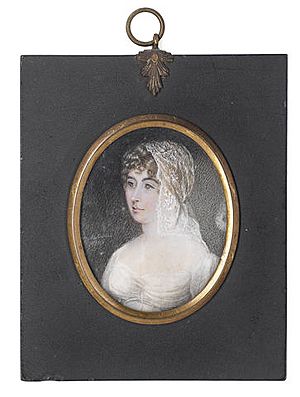
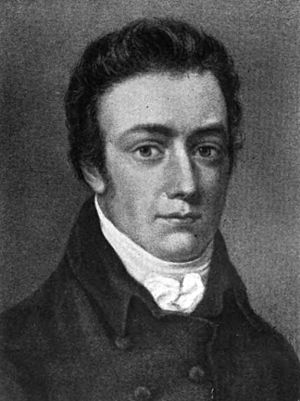
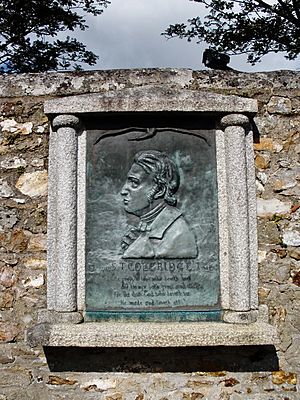
Cambridge and Somerset
At Jesus College, Coleridge was introduced to political and theological ideas then considered radical, including those of the poet Robert Southey with whom he collaborated on the play The Fall of Robespierre. Coleridge joined Southey in a plan, later abandoned, to found a utopian commune-like society, called Pantisocracy, in the wilderness of Pennsylvania. In 1795, the two friends married sisters Sara and Edith Fricker, in St Mary Redcliffe, Bristol, but Coleridge's marriage with Sara proved unhappy. He grew to detest his wife, whom he married mainly because of social constraints. Following the birth of their fourth child, he eventually separated from her.
A third sister, Mary, had already married a third poet, Robert Lovell, and both became partners in Pantisocracy. Lovell also introduced Coleridge and Southey to their future patron Joseph Cottle, but died of a fever in April 1796. Coleridge was with him at his death.
In 1796 he released his first volume of poems entitled Poems on Various Subjects, which also included four poems by Charles Lamb as well as a collaboration with Robert Southey and a work suggested by his and Lamb's schoolfriend Robert Favell. Among the poems were Religious Musings, Monody on the Death of Chatterton and an early version of The Eolian Harp entitled Effusion 35. A second edition was printed in 1797, this time including an appendix of works by Lamb and Charles Lloyd, a young poet to whom Coleridge had become a private tutor.
In 1796 he also privately printed Sonnets from Various Authors, including sonnets by Lamb, Lloyd, Southey and himself as well as older poets such as William Lisle Bowles.
Coleridge made plans to establish a journal, The Watchman, to be printed every eight days to avoid a weekly newspaper tax. The first issue of the short-lived journal was published in March 1796. It had ceased publication by May of that year.
The years 1797 and 1798, during which he lived in what is now known as Coleridge Cottage, in Nether Stowey, Somerset, were among the most fruitful of Coleridge's life. In 1795, Coleridge met poet William Wordsworth and his sister Dorothy. (Wordsworth, having visited him and being enchanted by the surroundings, rented Alfoxton Park, a little over three miles [5 km] away.) Besides The Rime of the Ancient Mariner, Coleridge composed the symbolic poem Kubla Khan; and the first part of the narrative poem Christabel. The writing of Kubla Khan, written about the Mongol emperor Kublai Khan and his legendary palace at Xanadu, was said to have been interrupted by the arrival of a "Person from Porlock" – an event that has been embellished upon in such varied contexts as science fiction and Nabokov's Lolita. During this period, he also produced his much-praised "conversation poems" This Lime-Tree Bower My Prison, Frost at Midnight, and The Nightingale.
In 1798, Coleridge and Wordsworth published a joint volume of poetry, Lyrical Ballads, which proved to be the starting point for the English romantic age. Wordsworth may have contributed more poems, but the real star of the collection was Coleridge's first version of The Rime of the Ancient Mariner. It was the longest work and drew more praise and attention than anything else in the volume. In the spring Coleridge temporarily took over for Rev. Joshua Toulmin at Taunton's Mary Street Unitarian Chapel while Rev. Toulmin grieved over the death of his daughter Jane. Poetically commenting on Toulmin's strength, Coleridge wrote in a 1798 letter to John Prior Estlin, "I walked into Taunton (eleven miles) and back again, and performed the divine services for Dr. Toulmin. I suppose you must have heard that his daughter, (Jane, on 15 April 1798) in a melancholy derangement, suffered herself to be swallowed up by the tide on the sea-coast between Sidmouth and Bere [sic] (Beer). These events cut cruelly into the hearts of old men: but the good Dr. Toulmin bears it like the true practical Christian, – there is indeed a tear in his eye, but that eye is lifted up to the Heavenly Father."
West Midlands and the North
Coleridge also worked briefly in Shropshire, where he came in December 1797 as locum to its local Unitarian minister, Dr Rowe, in their church in the High Street at Shrewsbury. He is said to have read his Rime of the Ancient Mariner at a literary evening in Mardol. He was then contemplating a career in the ministry, and gave a probationary sermon in High Street church on Sunday, 14 January 1798. William Hazlitt, a Unitarian minister's son, was in the congregation, having walked from Wem to hear him. Coleridge later visited Hazlitt and his father at Wem but within a day or two of preaching he received a letter from Josiah Wedgwood II, who had offered to help him out of financial difficulties with an annuity of £150 (approximately £13,000 in today's money) per year on condition he give up his ministerial career. Coleridge accepted this, to the disappointment of Hazlitt who hoped to have him as a neighbour in Shropshire.
From 16 September 1798, Coleridge and the Wordsworths left for a stay in Germany; Coleridge soon went his own way and spent much of his time in university towns. In February 1799 he enrolled at the University of Göttingen, where he attended lectures by Johann Friedrich Blumenbach and Johann Gottfried Eichhorn. During this period, he became interested in German philosophy, especially the transcendental idealism and critical philosophy of Immanuel Kant, and in the literary criticism of the 18th-century dramatist Gotthold Lessing. Coleridge studied German and, after his return to England, translated the dramatic trilogy Wallenstein by the German Classical poet Friedrich Schiller into English. He continued to pioneer these ideas through his own critical writings for the rest of his life (sometimes without attribution), although they were unfamiliar and difficult for a culture dominated by empiricism.
In 1799, Coleridge and the Wordsworths stayed at Thomas Hutchinson's farm on the River Tees at Sockburn, near Darlington.
It was at Sockburn that Coleridge wrote his ballad-poem Love, addressed to Sara Hutchinson. The knight mentioned is the mailed figure on the Conyers tomb in ruined Sockburn church. The figure has a wyvern at his feet, a reference to the Sockburn Worm slain by Sir John Conyers (and a possible source for Lewis Carroll's Jabberwocky).
The worm was supposedly buried under the rock in the nearby pasture; this was the 'greystone' of Coleridge's first draft, later transformed into a 'mount'. The poem was a direct inspiration for John Keats' famous poem La Belle Dame Sans Merci.
Coleridge's early intellectual debts, besides German idealists like Kant and critics like Lessing, were first to William Godwin's Political Justice, especially during his Pantisocratic period, and to David Hartley's Observations on Man, which is the source of the psychology which is found in Frost at Midnight. Hartley argued that one becomes aware of sensory events as impressions, and that "ideas" are derived by noticing similarities and differences between impressions and then by naming them. Connections resulting from the coincidence of impressions create linkages, so that the occurrence of one impression triggers those links and calls up the memory of those ideas with which it is associated (See Dorothy Emmet, "Coleridge and Philosophy").
Coleridge was critical of the literary taste of his contemporaries, and a literary conservative insofar as he was afraid that the lack of taste in the ever growing masses of literate people would mean a continued desecration of literature itself.
In 1800, he returned to England and shortly thereafter settled with his family and friends in Greta Hall at Keswick in the Lake District of Cumberland to be near Grasmere, where Wordsworth had moved. He was a houseguest of the Wordsworths' for eighteen months, but was a difficult houseguest, as his dependency on laudanum grew and his frequent nightmares would wake the children. He was also a fussy eater, to Dorothy Wordsworth's frustration, who had to cook. For example, not content with salt, Coleridge sprinkled cayenne pepper on his eggs, which he ate from a teacup. His marital problems, nightmares, illnesses, tensions with Wordsworth, and a lack of confidence in his poetic powers fuelled the composition of Dejection: An Ode and an intensification of his philosophical studies.
In 1802, Coleridge took a nine-day walking holiday in the fells of the Lake District. Coleridge is credited with the first recorded descent of Scafell to Mickledore via Broad Stand, although this was more due to his getting lost than a keenness for mountaineering.
Remains
Coleridge is buried in the aisle of St. Michael's Parish Church in Highgate, London. He was originally buried at Old Highgate Chapel, next to the main entrance of Highgate School, but was re-interred in St. Michael's in 1961. Coleridge could see the red door of the then new church from his last residence across the green, where he lived with a doctor he had hoped might cure him (in a house owned until 2022 by Kate Moss). When it was discovered Coleridge's vault had become derelict, the coffins – Coleridge's and those of his wife, daughter, son-in-law, and grandson – were moved to St. Michael's after an international fundraising appeal.
Drew Clode, a member of St. Michael's stewardship committee states, "they put the coffins in a convenient space which was dry and secure, and quite suitable, bricked them up and forgot about them". A recent excavation revealed the coffins were not in the location most believed, the far corner of the crypt, but actually below a memorial slab in the nave inscribed with: "Beneath this stone lies the body of Samuel Taylor Coleridge".
St. Michael's plans to restore the crypt and allow public access. Says vicar Kunle Ayodeji of the plans: "...we hope that the whole crypt can be cleared as a space for meetings and other uses, which would also allow access to Coleridge’s cellar."
Poetry
Coleridge is one of the most important figures in English poetry. His poems directly and deeply influenced all the major poets of the age. He was known by his contemporaries as a meticulous craftsman who was more rigorous in his careful reworking of his poems than any other poet, and Southey and Wordsworth were dependent on his professional advice. His influence on Wordsworth is particularly important because many critics have credited Coleridge with the very idea of "Conversational Poetry". The idea of utilising common, everyday language to express profound poetic images and ideas for which Wordsworth became so famous may have originated almost entirely in Coleridge’s mind. It is difficult to imagine Wordsworth’s great poems, The Excursion or The Prelude, ever having been written without the direct influence of Coleridge’s originality.
As important as Coleridge was to poetry as a poet, he was equally important to poetry as a critic. His philosophy of poetry, which he developed over many years, has been deeply influential in the field of literary criticism. This influence can be seen in such critics as A. O. Lovejoy and I. A. Richards.
The Rime of the Ancient Mariner, Christabel, and Kubla Khan
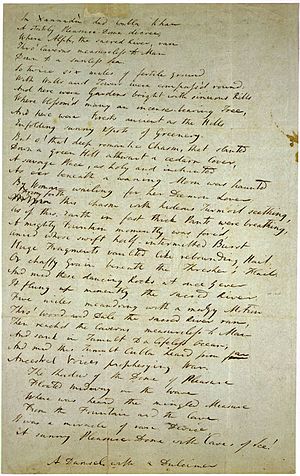
Coleridge is arguably best known for his longer poems, particularly The Rime of the Ancient Mariner and Christabel. Even those who have never read the Rime have come under its influence: its words have given the English language the metaphor of an albatross around one's neck, the quotation of "water, water everywhere, nor any drop to drink" (almost always rendered as "but not a drop to drink"), and the phrase "a sadder and a wiser man" (usually rendered as "a sadder but wiser man"). The phrase "All creatures great and small" may have been inspired by The Rime: "He prayeth best, who loveth best;/ All things both great and small;/ For the dear God who loveth us;/ He made and loveth all." Millions more who have never read the poem nonetheless know its story thanks to the 1984 song "Rime of the Ancient Mariner" by the English heavy metal band Iron Maiden. Christabel is known for its musical rhythm, language, and its Gothic tale.
Kubla Khan, or, A Vision in a Dream, A Fragment, although shorter, is also widely known. Both Kubla Khan and Christabel have an additional "Romantic" aura because they were never finished. Stopford Brooke characterised both poems as having no rival due to their "exquisite metrical movement" and "imaginative phrasing."
Conversation poems
|
|
The eight of Coleridge's poems listed above are now often discussed as a group entitled "Conversation poems". The term itself was coined in 1928 by George McLean Harper, who borrowed the subtitle of The Nightingale: A Conversation Poem (1798) to describe the seven other poems as well. The poems are considered by many critics to be among Coleridge's finest verses; thus Harold Bloom has written, "With Dejection, The Ancient Mariner, and Kubla Khan, Frost at Midnight shows Coleridge at his most impressive." They are also among his most influential poems, as discussed further below.
Harper himself considered that the eight poems represented a form of blank verse that is "...more fluent and easy than Milton's, or any that had been written since Milton". In 2006 Robert Koelzer wrote about another aspect of this apparent "easiness", noting that Conversation poems such as "... Coleridge's The Eolian Harp and The Nightingale maintain a middle register of speech, employing an idiomatic language that is capable of being construed as un-symbolic and un-musical: language that lets itself be taken as 'merely talk' rather than rapturous 'song'."
The last ten lines of Frost at Midnight were chosen by Harper as the "best example of the peculiar kind of blank verse Coleridge had evolved, as natural-seeming as prose, but as exquisitely artistic as the most complicated sonnet." The speaker of the poem is addressing his infant son, asleep by his side:
In 1965, M. H. Abrams wrote a broad description that applies to the Conversation poems: "The speaker begins with a description of the landscape; an aspect or change of aspect in the landscape evokes a varied by integral process of memory, thought, anticipation, and feeling which remains closely intervolved with the outer scene. In the course of this meditation the lyric speaker achieves an insight, faces up to a tragic loss, comes to a moral decision, or resolves an emotional problem. Often the poem rounds itself to end where it began, at the outer scene, but with an altered mood and deepened understanding which is the result of the intervening meditation." In fact, Abrams was describing both the Conversation poems and later poems influenced by them. Abrams' essay has been called a "touchstone of literary criticism". As Paul Magnuson described it in 2002, "Abrams credited Coleridge with originating what Abrams called the 'greater Romantic lyric', a genre that began with Coleridge's 'Conversation' poems, and included Wordsworth's Tintern Abbey, Shelley's Stanzas Written in Dejection and Keats's Ode to a Nightingale, and was a major influence on more modern lyrics by Matthew Arnold, Walt Whitman, Wallace Stevens, and W. H. Auden."
Literary criticism
Biographia Literaria
In addition to his poetry, Coleridge also wrote influential pieces of literary criticism including Biographia Literaria, a collection of his thoughts and opinions on literature which he published in 1817. The work delivered both biographical explanations of the author's life as well as his impressions on literature. The collection also contained an analysis of a broad range of philosophical principles of literature ranging from Aristotle to Immanuel Kant and Schelling and applied them to the poetry of peers such as William Wordsworth. Coleridge's explanation of metaphysical principles were popular topics of discourse in academic communities throughout the 19th and 20th centuries, and T.S. Eliot stated that he believed that Coleridge was "perhaps the greatest of English critics, and in a sense the last." Eliot suggests that Coleridge displayed "natural abilities" far greater than his contemporaries, dissecting literature and applying philosophical principles of metaphysics in a way that brought the subject of his criticisms away from the text and into a world of logical analysis that mixed logical analysis and emotion. However, Eliot also criticises Coleridge for allowing his emotion to play a role in the metaphysical process, believing that critics should not have emotions that are not provoked by the work being studied. Hugh Kenner in Historical Fictions, discusses Norman Fruman's Coleridge, the Damaged Archangel and suggests that the term "criticism" is too often applied to Biographia Literaria, which both he and Fruman describe as having failed to explain or help the reader understand works of art. To Kenner, Coleridge's attempt to discuss complex philosophical concepts without describing the rational process behind them displays a lack of critical thinking that makes the volume more of a biography than a work of criticism.
In Biographia Literaria and his poetry, symbols are not merely "objective correlatives" to Coleridge, but instruments for making the universe and personal experience intelligible and spiritually covalent. To Coleridge, the "cinque spotted spider," making its way upstream "by fits and starts," [Biographia Literaria] is not merely a comment on the intermittent nature of creativity, imagination, or spiritual progress, but the journey and destination of his life. The spider's five legs represent the central problem that Coleridge lived to resolve, the conflict between Aristotelian logic and Christian philosophy. Two legs of the spider represent the "me-not me" of thesis and antithesis, the idea that a thing cannot be itself and its opposite simultaneously, the basis of the clockwork Newtonian world view that Coleridge rejected. The remaining three legs—exothesis, mesothesis and synthesis or the Holy trinity—represent the idea that things can diverge without being contradictory. Taken together, the five legs—with synthesis in the center, form the Holy Cross of Ramist logic. The cinque-spotted spider is Coleridge's emblem of holism, the quest and substance of Coleridge's thought and spiritual life.
Coleridge and the influence of the Gothic
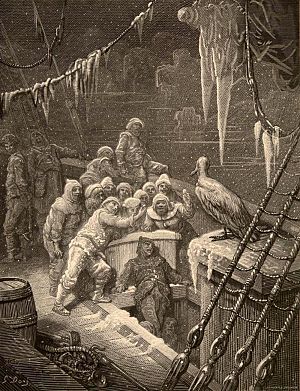
Coleridge wrote reviews of Ann Radcliffe's books and The Mad Monk, among others.
Coleridge's, such as The Rime of the Ancient Mariner (1798), Christabel and Kubla Khan (published in 1816, but known in manuscript form before then), certainly influenced other poets and writers of the time. Poems like these both drew inspiration from and helped to inflame the craze for Gothic romance. Coleridge also made considerable use of Gothic elements in his commercially successful play Remorse.
Mary Shelley, who knew Coleridge well, mentions The Rime of the Ancient Mariner twice directly in Frankenstein, and some of the descriptions in the novel echo it indirectly. Although William Godwin, her father, disagreed with Coleridge on some important issues, he respected his opinions and Coleridge often visited the Godwins. Mary Shelley later recalled hiding behind the sofa and hearing his voice chanting The Rime of the Ancient Mariner.
C. S. Lewis also makes mention of his name in The Screwtape Letters (as a poor example of prayer, in which the devils should encourage).
Religious beliefs
Although his father was an Anglican vicar, Coleridge worked as a Unitarian preacher between 1796 and 1797. He eventually returned to the Church of England in 1814. His most noteworthy writings on religion are Lay Sermons (1817), Aids to Reflection (1825) and The Constitution of Church and State (1830).
Theological legacy
Despite being mostly remembered today for his poetry and literary criticism, Coleridge was also (perhaps in his own eyes primarily) a theologian. His writings include discussions of the status of scripture, the doctrines of the Fall, justification and sanctification, and the personality and infinity of God. A major figure in the Anglican theology of his day, his writings are still regularly referred to by contemporary Anglican theologians. F. D. Maurice, F. J. A. Hort, F. W. Robertson, B. F. Westcott, John Oman and Thomas Erskine (once called the "Scottish Coleridge") were all influenced by him.
Political thinking
Coleridge was also a political thinker. Early in life he was a political radical, and an enthusiast for the French Revolution. However he subsequently developed a more conservative view of society, somewhat in the manner of Edmund Burke. He was critical of the French Constitution of 1799, adopted following the Coup of 18 Brumaire, which he regarded as oligarchic.
Although seen as cowardly treachery by the next generation of Romantic poets, Coleridge's later thought became a fruitful source for the evolving radicalism of J. S. Mill. Mill found three aspects of Coleridge's thought especially illuminating:
- First, there was Coleridge's insistence on what he called "the Idea" behind an institution – its social function, in later terminology – as opposed to the possible flaws in its actual implementation. Coleridge sought to understand meaning from within a social matrix, not outside it, using an imaginative reconstruction of the past (Verstehen) or of unfamiliar systems.
- Secondly, Coleridge explored the necessary conditions for social stability – what he termed Permanence, in counterbalance to Progress, in a polity – stressing the importance of a shared public sense of community, and national education.
- Coleridge also usefully employed the organic metaphor of natural growth to shed light on the historical development of British history, as exemplified in the common law tradition – working his way thereby towards a sociology of jurisprudence.
Coleridge also despised Adam Smith.
Collected works
The current standard edition is The Collected Works of Samuel Taylor Coleridge, edited by Kathleen Coburn and many others from 1969 to 2002. This collection appeared across 16 volumes as Bollingen Series 75, published variously by Princeton University Press and Routledge & Kegan Paul. The set is broken down as follows into further parts, resulting in a total of 34 separate printed volumes:
- Lectures 1795 on Politics and Religion (1971);
- The Watchman (1970);
- Essays on his Times in the Morning Post and the Courier (1978) in 3 vols;
- The Friend (1969) in 2 vols;
- Lectures, 1808–1819, on Literature (1987) in 2 vols;
- Lay Sermons (1972);
- Biographia Literaria (1983) in 2 vols;
- Lectures 1818–1819 on the History of Philosophy (2000) in 2 vols;
- Aids to Reflection (1993);
- On the Constitution of the Church and State (1976);
- Shorter Works and Fragments (1995) in 2 vols;
- Marginalia (1980 and following) in 6 vols;
- Logic (1981);
- Table Talk (1990) in 2 vols;
- Opus Maximum (2002);
- Poetical Works (2001) in 6 vols (part 1 – Reading Edition in 2 vols; part 2 – Variorum Text in 2 vols; part 3 – Plays in 2 vols).
In addition, Coleridge's letters are available in: The Collected Letters of Samuel Taylor Coleridge (1956–71), ed. Earl Leslie Griggs, 6 vols. (Oxford: Clarendon Press).
See also
 In Spanish: Samuel Taylor Coleridge para niños
In Spanish: Samuel Taylor Coleridge para niños
- Organic form
- Romantic epistemology
- Lake Poets


